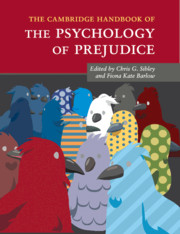Book contents
- Frontmatter
- Dedication
- Contents
- List of Figures
- List of Tables
- Notes on the Contributors
- Part I General Theoretical Perspectives
- 1 An Introduction to the Psychology of Prejudice
- 2 Evolutionary Approaches to Stereotyping and Prejudice
- 3 From Prejudice to Social Change: A Social Identity Perspective
- 4 Ingroup Projection as a Challenge of Diversity: Consensus about and Complexity of Superordinate Categories
- 5 Intergroup Discrimination: Ingroup Love or Outgroup Hate?
- 6 Intergroup Emotions Theory: Prejudice and Differentiated Emotional Reactions toward Outgroups
- 7 Intergroup Threats
- 8 Social Dominance Theory: Explorations in the Psychology of Oppression
- 9 The Dual Process Motivational Model of Ideology and Prejudice
- 10 Is Prejudice Heritable? Evidence from Twin Studies
- Part II Prejudice in Specific Domains
- Part III Prejudice Reduction and Analysis in Applied Contexts
- Index
- References
4 - Ingroup Projection as a Challenge of Diversity: Consensus about and Complexity of Superordinate Categories
from Part I - General Theoretical Perspectives
Published online by Cambridge University Press: 17 November 2016
- Frontmatter
- Dedication
- Contents
- List of Figures
- List of Tables
- Notes on the Contributors
- Part I General Theoretical Perspectives
- 1 An Introduction to the Psychology of Prejudice
- 2 Evolutionary Approaches to Stereotyping and Prejudice
- 3 From Prejudice to Social Change: A Social Identity Perspective
- 4 Ingroup Projection as a Challenge of Diversity: Consensus about and Complexity of Superordinate Categories
- 5 Intergroup Discrimination: Ingroup Love or Outgroup Hate?
- 6 Intergroup Emotions Theory: Prejudice and Differentiated Emotional Reactions toward Outgroups
- 7 Intergroup Threats
- 8 Social Dominance Theory: Explorations in the Psychology of Oppression
- 9 The Dual Process Motivational Model of Ideology and Prejudice
- 10 Is Prejudice Heritable? Evidence from Twin Studies
- Part II Prejudice in Specific Domains
- Part III Prejudice Reduction and Analysis in Applied Contexts
- Index
- References
Summary
As is often done, we could begin such a chapter in a volume on intergroup conflict with a dire description of the state of human society and the continuing menace of social discrimination, prejudice, injustice, and ethnic violence. However, a children's book by the Austrian writer Edith Schreiber-Wicke (1990), whose title may be translated as “When the crows were still colorful,” provides a fable that is more fun, yet insightful. It describes the story of the crows when they still came in all sorts of colors and patterns – orange with blue stripes, green with yellow spots, and so on – until one day a snowman asked the fateful (and probably spiteful) question of what a real, true crow looked like. Now the yellow-with-blue-spotted crows declared yellow with blue spots was the true color of crows, but the lilac crows argued the ur-crow was lilac colored, and all the other crows also claimed their colors were the real ones. There was arguing and quarreling; the crows began to fly with like-colored others only. The fighting ended only when one day a black rain turned all animals black. Afterward, only the crows stayed black and no longer had a reason to argue. The moral of the story? Obviously: ingroup projection is a challenge of diversity! And if we do not want to buy social harmony with dull sameness, we had better think of a more creative way to appreciate and enjoy differences.
Ingroup projection is the perception or claim that one's own group is more prototypical for a higher-order superordinate identity, hence more normative and positive, than a relevant comparison outgroup is, or more prototypical at least than the outgroup thinks the ingroup is. In the present chapter, we briefly outline the ingroup projection model (IPM; Mummendey & Wenzel, 1999; Wenzel, Mummendey, & Waldzus, 2007), discuss its key concepts and relevant recent findings, and essentially argue for two ways in which we need to construe our superordinate identities to reduce tension between diverse and divergent groups included in them: We need to advance consensus about the superordinate identity in question, and about the complexity of its representation.
- Type
- Chapter
- Information
- The Cambridge Handbook of the Psychology of Prejudice , pp. 65 - 89Publisher: Cambridge University PressPrint publication year: 2016
References
- 21
- Cited by



